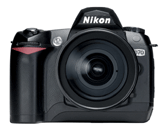It's not just people in front of the camera who are smiling these days, it is also those taking the pictures. Digital cameras have come down in price'some models cost less than $200'while the quality, features and ease of use keep increasing.Many cameras also record video as well as still pictures and, using a system call PictBridge, can even connect directly to printers without having to go through a computer.Shyam Nagrani, principal analyst in consumer electronics for iSuppli Corp. of El Segundo, Calif., said 46.4 million digital still cameras were sold last year, and he predicted another 58.5 million will be sold this year.In the U.S. market, Forrester Research Inc. of Cambridge, Mass., said 27.4 percent of households had a digital camera by the end of 2003, and more than 60 percent will have them in 2009, with many more being sold to public and private sector organizations. And this doesn't count camera phones, which analysts expect also to have 60 percent market penetration by then.'Digital cameras are not a standalone device like an analog camera, and they bring value over and above a regular camera,' said Ted Schadler, vice president and principal analyst for Forrester. 'They are part of your network, you can send images around, use them in different places and print them in different ways.'This has brought a new approach to photography and new players into the market: computer vendors.'Hewlett-Packard and Gateway, for example, come in with a PC-centric approach, which is a new thing for traditional camera companies to compete with,' Schadler said. 'Because a digital camera is a connected device, you need a good software platform, and computer companies understand this.'Hewlett-Packard sells cameras under its own name and even includes them with some consumer PC packages. Dell, on the other hand, sells devices from other manufacturers and acts as an additional sales channel for them rather than as a competitor. Of the top five digital camera companies, however, only one has an electronics background; the other four are all well established in the film arena.[IMGCAP(2)]The top seller last year, according to Nagrani, was consumer electronics giant Sony, with 19.2 percent of the market. But Sony lost a bit of market share last year, and Canon slipped in right behind it at 19.1 percent. The next three competitors were also tightly grouped. Fuji led with 13.4 percent, Olympus had 13.1 percent and Nikon 12.8 percent.The order will shift a bit this year as Nikon and Canon are both growing, while the other three are losing relative market share. Since the overall market for digital cameras continues to grow, however, these vendors are selling more cameras than before.The top five account for more than three-quarters of all digital cameras sold. The rest of the market is split between film and electronics vendors including Eastman Kodak, Hewlett-Packard, Panasonic and Pentax.One factor in both Nikon's and Canon's success lies with converting their existing film user base over to digital with their high-end digital single-lens reflex cameras.'Canon was the first to design their camera body to take any Canon lens on the market,' says Nagrani. 'There are 200 million Canon lenses in the world, so this is an incredible opportunity for those who are fond of SLRs.'Digital SLR is the highest of the three main categories constituting the digital camera hierarchy. Examples include the Nikon D70, Canon EOS Digital Rebel, Pentax *ist D, Fuji FinePix S3 Pro, Konica Minolta Dimage XT and the Olympus E-1.These cameras let you change lenses and filters, have the highest resolution'6 to 12 megapixels'and provide the greatest level of control over every aspect of taking a picture. But they are expensive ($900 and up, often without a lens), heavy (around 20 ounces, not counting the lens, battery, storage media or flash) and complex. They also lack some of the features, such as video recording and built-in flash, of lower-end models. These are strictly pro machines.[IMGCAP(3)]In the middle lie the professional class cameras such as the Olympus C770 Ultra Zoom, Sony DSC F828 and Kodak EasyShare DX7590. These 4- to 8-megapixel models run in the $500 to $1,000 range and weigh about a pound, including the lens. They offer better components and a greater degree of control over image quality than point-and-shoot cameras, but not as much as the SLRs.They also provide video recording. Unlike SLRs, you can't change lenses.At the bottom rung are the cameras most people will be interested in, the point-and-shoot models. They are small enough to carry in a pocket or purse and cost $100 to $400. They provide the greatest ease of use, and most record audio and video in addition to still images. With resolutions now in the 2- to 5-megapixel range, they provide good enough quality for most nonprofessional applications.In addition to these three main categories, there are also special-use cameras. Pentax, for example, has built a digital camera into a set of binoculars'its DigiBino DB100'and developed a water-resistant point-and-shoot model, the Optio 33WR. Then there are the tens of millions of cell phones being sold with cameras included.'Don't overlook camera phones,' says Schadler. 'The first megapixel camera phones are coming to the U.S. this year, and they take a pretty good picture.'
Nikon's Coolpix 2200 is a $150, 2-megapixel point-and-shoot camera with some video capability.
Panasonic's Lumix DMC-FZ20K is a 5-megapixel professional camera that uses a Leica lens. It's priced at $600.
The company's $1,300 D70 Outfit is a 6.1-megapixel digital SLR you can use with a range of lenses.









